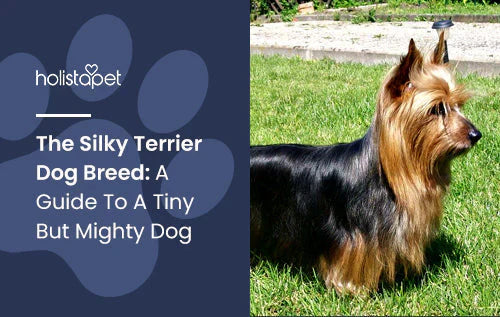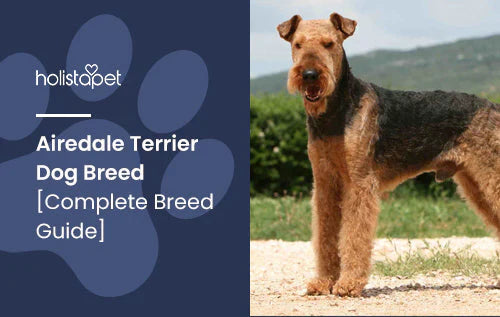Because of its long, thin hair, the Silky Terrier is often seen with a trendy ponytail of sorts atop its head — It's definitely an elegant-looking dog. But make no mistake, this breed is a ball of energy that's ready to roughhouse, dig in the dirt, and take long hikes in the woods. The Silky Terrier is an energetic dog breed with a lot of personality. They love to be around people at all times, following you around the house and getting their nose into your chores.
Loyal and devoted, this dog has a big heart and isn't afraid to act as a watchdog. The Silky Terrier temperament is a special dog that needs a special family to keep them in line. Is the Silky Terrier right for your home? Find out exactly what the Silky Terrier is all about in this complete dog breed guide!
Characteristics (Physical)
The Silky Terrier is a striking breed. They may be small and quaint but they bolster a very imposing look. The Silky always looks confident, with their head held high and a very strong expression. They have a long, silky coat and a tiny but might body and mentality.
Breed Size
Not quite a toy breed, the Silky Terrier is still a small dog breed. They are usually about 10 pounds and grow nine to 10 inches tall at the shoulders.
Body
The Silky's body is moderately low set. The breed is a bit longer than tall. Their shoulders are laid back, their front legs strong, straight, and distinctly boned. Their feet are small, with the American Kennel Club, an association that documents dog breeds, calling them "cat-like." Their thighs are well-muscled on the back legs.

Head
The Silky has a strong head that's wedge-shaped and moderately long. They have a piercing expression, including small, dark, almond-shaped eyes and small V-shaped ears set high atop their head.
Tail
This breed has a docked tail that's set very high.
Personality
The Silky Terrier may be small and elegant in appearance, but this is a terrier that's active, outgoing, and not afraid to get dirty. You'll often find the Silky Terrier roughhousing with the bigger dogs at the dark park or digging large holes in the backyard. Despite being a "toy" breed, the Silky Terrier isn't satisfied just sitting on your lap or being carried around in a purse.
This is a dog that needs a family with an active lifestyle. They are a tenacious breed that loves to challenge themselves, whether it's doing a tough hike or racing after tennis balls in the backyard. Without this type of stimulation, the Silky Terrier might become a bit destructive, including digging, barking, and chasing.
A Family Dog
The Silky Terrier loves to spend time with their family. This energetic pup will love accompanying you during your chores or errands. Whether it's making the bed or heading to the farmer's market, make sure to bring your Silky Terrier with you! This will not only keep your dog happy but out of trouble.
This is a mischievous dog that shouldn't be left alone for long periods of time. They need companionship to be happy. This is a loyal dog that is happiest when cuddling with you on the couch, going to the grocery store, or taking trips to the dog park. Despite their small size, the Silky Terrier is courageous and brave.
They're not usually afraid of strangers or random dogs. They will even act as a watchdog if they feel their family needs to be alerted. This dog is alert and always aware of their surroundings. This confidence means the Silky Terrier is a bit assertive at times, in spite of their stout size.
If you have the time to dedicate to this spunky, sporty dog, the Silky Terrier might be a good choice. These pups are loyal and entertaining companions that will show you endless love and devotion.

Dog Breed Exercise
The energetic Silky Terrier needs one to two hours of exercise each day. This can be anything from a long hike in the woods to a game of fetch down a long hallway in your apartment. A variety of exercises will keep your Silky Terrier stimulated and satisfied, reducing destructive behavior inside and outside the home. You might even want to try agility courses and other organized activities and canine sports.
Even though the Silky Terrier needs an active lifestyle and family to thrive, that doesn't mean they need to live in an expansive home on a sprawling lawn. The Silky Terrier is perfectly fine in a small apartment in the city as long as they get a good amount of exercise and family time.
Training
This breed may be small but they are tenacious. They are known to be a bit stubborn and need a devoted owner who can establish themselves as a pack leader. You'll need consistency to train your Silky Terrier properly so be prepared! Always start training and socializing your dog as a puppy.
The longer you wait, the harder it will be to break bad habits. Obedience classes and proper socialization are a great way to start. Dog trainers will give you skills you can use with your dog at home to remain consistent and in control.

Digging
The Silky Terrier has a few bad habits that need to be worked on. They LOVE digging. Some experts will even recommend getting another breed entirely if you want to save your gardens from the terrier's love of playing in the dirt. You might need to train your dog to dig in one particular area of the yard to ensure the rest of your yard isn't filled with holes.
Prey Drive
Silkies also have a strong prey drive. They will chase small animals like cats, rodents, and sometimes even other dogs. This dog should be properly taught how to walk on a leash since this is a breed that should be on a leash or harness whenever they are outside, whether it's at a park or in the backyard. A Silky Terrier may end up running off if they see a cat or squirrel in the yard.
Barking
Another terrier trait, the Silky Terrier loves to bark. The American Kennel Club has their barking as a four out of five, with five being "very vocal." The Silky will bark when they think it's necessary, including when a stranger approaches. But the dog also enjoys barking as a hobby. You can train your terrier to listen to commands like "quiet." Just keep in mind that they will continue to bark during times when they think it's important.
The Silky Terrier has difficulty with house training. It can be tough to get them to stop using the potty inside so you will need to invest in pee pads and keep your Silky Terrier in certain spots of the home when you're away. Remember to always be consistent. As a puppy, you will need to keep your Silky on a leash at all times, bringing them outside every 30 minutes or so.
Related: How to Stop Dog Barking When Left Alone [CBD Can Help]
Breed History
In case you're curious how this small, sleek pup has so much energy and confidence, just look at their relatively short history as a breed. The Silky has tough ancestors, vermin-catching terriers in Europe. The breed developed in Australia in the late 1800s. Yorkshire Terriers and Australian Terriers were crossed to create a breed that had the body of the Australian Terrier and the coat of the Yorkie.
Initially, some of the puppies looked like Yorkshire Terriers, and some like Australian Terriers. And some looked like the Silkie we know today. It only took a few generations to finally see the Silkie form into a breed of its own. In 1906, Australian breeders came up with a breed standard, identifying key physical traits and personality guidelines. Another standard was drawn up in Victoria in 1909. The standards didn't add up too well and breeders started debating about weight requirements.

Meanwhile, breeders were also arguing about what the Silky Terrier's weight and name should be. It was previously called the Sydney Silky Terrier and then the Australian Silky Terrier. But when the breed made its way to the United States, it became known as simply the Silky Terrier. A breed standard was compromised in 1926. The name came a bit later. In 1955, the American Kennel Club recognized the breed. Since then, silky terriers have slowly grown in popularity.
Common Health Problems
How long do silky terriers live? All dogs, especially purebred pups, have the potential to develop genetic health problems. Always go with a reputable and registered breeder who can provide health guarantees for their puppies. These breeders will also submit their dogs for evaluations, removing dogs with diseases from the breeding pool.
Eye problems are common with Silkies. This includes cataracts and progressive retinal atrophy. Check that your chosen breeder has documentation from the Canine Eye Registration Foundation from the last year. Cataracts occur when there is cloudiness in the eye's lens. This can lead to vision loss, although the light will still pass through the lens, allowing your pet to see light and dark. This is a more common issue for older dogs but genetics are also a major factor.
Spotting Conditions Early
You should also ensure that your breeder has had your puppy cleared with the Orthopedic Foundation for Animals. That's because Silkies can, unfortunately, develop luxating patellar — a condition that causes their kneecap to pop out of place. According to VCA Hospitals, many toy breeds have a genetic predisposition for this condition.
The kneecap will dislocate because the patellar ligament is not on the center of the shin bone. This is especially common if your dog is bowlegged. If your dog is experiencing this for several months, the femur may wear down and the knee will completely dislocate. Your dog will often not show signs of discomfort. Instead, they will avoid putting pressure on the affected limb.
They might not be as active, seeming more lethargic. It might be tougher for them to get up. If you suspect that your dog is suffering from luxating patellar, take them to the vet immediately to avoid them becoming lame. The Silky Terrier can suffer from Legg-Calve-Perthes disease, another common issue with smaller breeds. This is a disorder where one of the leg bones doesn't receive adequate blood supply, causing the bone to degrade. This will require surgery so make sure that your puppy's breeder has checked for this in its breeding dogs.

How to Care for this Breed
Silkies are a bit needy — this isn't a low-maintenance pooch. For your Silky Terrier to be happy, you'll need to spend a lot of quality time with them. This can just be letting your dog follow you room-to-room as you go about your daily activities or cuddling on the couch after work. Without attention, the Silky becomes very mischievous. This is not a dog you can leave alone for hours a day. Not only will this breed become upset and lonely, but they will also often rip apart your furniture or start scratching at doors.
Digging and chewing are the favorite activities of a bored, mischievous Silky. The most important activity is exercise! This is a breed that needs up to two hours of exercise a day to be happy. This can be long walks, playing in a park, or fetch in the backyard. But make sure you have a very secure harness or leash. And you must have a fenced-in backyard. Because of their prey drive, the Silky will give chance to small animals.
Make sure your Silky Terrier has a lot of toys. This can help your pup satisfy their strong prey drive. Teach them to play fetch and provide them with toys for when they are playing on their own. You can also take part in organized sports, like lure coursing.
Nutrition and Feeding for a Silky Terrier
Silky dog are small dogs. They need only about 1/2 to 3/4 cup of high-quality dry food a day. This should be divided into two meals, one in the morning and one at night. This will help your dog with digestion, reducing stomach aches and bloating.

Look for dog food that has meat as the first ingredient. Make sure it's not "meal." Organ meat is also an important dog food ingredient. Carbohydrates and healthy fats will give your dog energy. Fiber, electrolytes, and vitamins are also beneficial to your dog's health. Speak with your vet about the exact amount your dog should eat it depends on how old is silky. This will depend on your dog's age, weight, activity level, and more. Vets might also recommend particular types of food or a certain diet if your silkie dog is suffering from particular ailments or allergies.
Coat Color And Grooming
The coat is the most recognizable part of the Silky Terrier's appearance. It's straight, single, glossy, and (surprise) silky in texture. You'll notice on adult Silkies that their coat follows their body's outline, concluding in a long, bushy top on their head. The legs will have shorter hair as well. The Silky only comes in one coat pattern: Blue and tan.
The blue will vary in shades, including "pigeon blue" or "slate blue." While the tan is deep and rich. The blue extends from the base of the skull to the top of the tail. The tan is on the dog's muzzle and cheeks, the base of the ears, and on the legs and feet.
Grooming
Despite their luxurious look, the Silky doesn't require a lot of extensive grooming. Simply brush and comb their coat two or three times a week. And a warm bath every month will keep your dog's coat clean and free of tangles. Small dogs are known to get dental complications because of the size of their mouths. Brush your Silky Terrier's teeth two to three times a week. This will remove tartar buildup and bacteria, and prevent your dog from getting gum disease.

Trim your dog's nails once or twice a month. If you hear the nails clicking on the floor, they're too long. If you are not experienced with nail clippers, bring your dog to a groomer or vet to get them trimmed and gain some pointers. Check your dog's ears each week for redness or dirt buildup because it can lead to infection. Wipe them out with a cotton ball that's been dampened with a gentle ear cleaner. Never insert something into the ear canal, like Q-tips. Only clean the outer ear.
Start this routine with your dog when they are a puppy. Brush them while they are young and handle their paws a lot to get them used to the process. After grooming, give your dog treats or other rewards to make it a positive experience.

Dog Rescue Groups
A lot of times, families pick small dogs because they see them as less work. In fact, a lot of smaller breeds don't mind a lack of exercise and might even tolerate being left alone while you work. But that's not the case with most Silky Terriers. This social and energetic dog can sometimes be too much for new dog owners, especially if they are unsure how to deal with digging, barking, and chasing. This behavior is often amplified if owners neglect their silky terriers.
Rescues will take Silkies that are in need of rehoming and properly train them, keeping them with experienced fosters before adoption. The rescues will also find Silkies in need of help at shelters. Some well-known rescues include the Silky Terrier Rescue and the California Silky Terrier Rescue.
Breed Organizations
Breed organizations aim to spread awareness about a particular breed throughout the country. They often do this through online information (like breed standards and educational documents) as well as events where Silky Terrier owners can come together to celebrate their dogs. The Silky Terrier Club of America often sponsors events that showcase what makes the Silky special, from dog shows to agility events.
You can also find organizations by state, like the Silky Terrier Club of Northern California. This allows owners that live a bit closer to each other to network, connect, and take part in regional events. The Silky Terrier Club of Northern California also offers obedience and training classes for Silkies.

More About the Silky Terrier
The Silky Terrier is clearly an active dog breed! But did you know that they are also no stranger to agility events? You'll often see them competing in herding, agility, rally, tracking, and fly ball events. This is a great way for the Silky to let loose and expend all of their excess energy. You'll also notice that the Silky has very special fur. The Silky Terrier has hair that's similar to a human's, meaning they don't shed as much as other dog breeds.
This is great news for neat freaks looking for a dog that's not going to get its fur all over the couch after a short cuddle session! If you can handle the spunky pup, you're looking at a puppy worth way more than their average $2,000 price tag. Always look for a trusted breeder that properly socializes puppies and you'll have a cuddly, loving, and energetic dog that's not afraid to get dirty and defend your honor.







![Probiotics For Dogs [Soft Chews] - HolistaPet](http://www.holistapet.com/cdn/shop/files/Probiotic-Infographic-1_472d7a29-e30c-435a-9638-1365d8c3a9f9.jpg?v=1725384841&width=104)



























Leave a comment
All comments are moderated before being published.
This site is protected by hCaptcha and the hCaptcha Privacy Policy and Terms of Service apply.